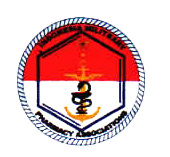PROTECTION OF INDONESIAN MIGRANT WORKERS FROM INTERNATIONAL CRIME SYNDICATES THROUGH THE MARITIME CONTROL SYSTEM
(1) Universitas Pertahanan Republik Indonesia
(*) Corresponding Author
Abstract
Maritime Security is a crucial element in maintaining national sovereignty and stability. Indonesia, as the largest archipelagic country in the world, faces significant challenges in securing its maritime territory, particularly from the threat of international crime syndicates through illegal migrant workers. These syndicates exploit migrant workers who are not registered with the government, causing them to become involved in transnational crimes as proxies for criminal syndicates. Indonesia's strategic position at the crossroads of international trade and migration routes makes it a prime target for these criminal activities. The less stringent monitoring of Indonesian citizens compared to foreign nationals further complicates prevention and countermeasures. International crime syndicates utilize illegal migrant workers to carry out various criminal activities such as terrorism, drug trafficking, and money laundering. These activities not only threaten national sovereignty and security but also damage Indonesia's reputation as a country that upholds human values and human rights. Therefore, addressing the threat from international crime syndicates through illegal migrant workers must be a top priority. The Indonesian government needs to undertake integrated efforts involving various agencies such as Ministries, the Navy, the Maritime Security Agency, the police, as well as international bodies and non-governmental organizations focused on human rights. Public participation and increased public awareness are also crucial in ensuring national security and sovereignty. The development of effective strategies and policies to prevent, detect, and address these illegal activities is essential to maintain Indonesia's national sovereignty and integrity.
Keywords: Maritime Security, Illegal Migrant Workers, International Crime Syndicates
References
Chellaney, B. (2010). Indian Ocean maritime security: energy, environmental and climate challenges. Journal of the Indian Ocean Region, 6(2), 155–168. https://doi.org/10.1080/19480881.2010.536662
Dieuzeide, H. (1975). INTERNATIONAL COOPERATION. Journal of Educational Television, 1(2), 6–8. https://doi.org/10.1080/1358165750010203
Hefner, M. K., & Hill, L. B. (2023). Naming, Blaming, and Claiming: Understanding Human Trafficking Victims’ Nondisclosure and Non-Reporting Behavior. Journal of Human Trafficking, 1–15. https://doi.org/10.1080/23322705.2023.2281212
Human Trafficking as Transnational Organized Crime. (2010). In Human Trafficking (pp. 83–111). Cambridge University Press. https://doi.org/10.1017/CBO9780511760433.006
IOM UN Migration Indonesia. (n.d.). Migrasi Tenaga Kerja. Https://Indonesia.Iom.Int/Labour-Migration.
Keamanan, B. (n.d.). Laporan Kinerja Triwulan Ii Bakamla Ri Periode Ta. 2023.
Nabiila Azzahra. (2024, May 29). 14 WNI Ditangkap di Hong Kong atas Dugaan Pencucian Uang. Tempo.
Nesadurai, H. E. S. (2013). Malaysia’s conflict with the Philippines and Indonesia over labour migration: economic security, interdependence and conflict trajectories. The Pacific Review, 26(1), 89–113. https://doi.org/10.1080/09512748.2013.755360
Saadat, S. Y. (2020). International cooperation for counter-terrorism: a strategic perspective. Journal of Policing, Intelligence and Counter Terrorism, 15(1), 83–93. https://doi.org/10.1080/18335330.2020.1732451
Saha, P. (2016). Indonesia’s potential as a maritime power. Maritime Affairs: Journal of the National Maritime Foundation of India, 12(2), 28–41. https://doi.org/10.1080/09733159.2016.1232951
Hugo, Graeme(2005) ‘The newinternational migration in Asia: challenges for pop ulation research’, Asian Population Studies 1(1): 93–120.
Kaplan, R. (2009), ‘Center stage for the twenty-first century’, Foreign Affairs, Vol. 88, no. 2.
Kaur, Amarjit (2010) ‘Labour migration in Southeast Asia: migration policies, labour exploitation and regulation’, Journal of the Asia Pacific Economy 15(1): 6–19
Rudolph, Christopher (2006) National Security and Immigration, Stanford, CA: Stanford University Press.
Susanti, V., Kosandi, M., Imam Subono, N., & Kartini, E. (2022). Criminological Study on Criminal Activities Human Trafficking in the Nusa Tenggara Timur Region (NTT), Indonesia. International Journal of Criminology and Sociology, 9, 182–191. https://doi.org/10.6000/1929-4409.2020.09.16
Ukhrowi, L. M., Karjaya, L. P., & Sood, M. (n.d.). Dampak Pekerja Migran Ilegal Terhadap Meningkatnya Kasus Human Trafficking di Pulau Lombok. In IJGD: Indonesian Journal of Global Discourse (Vol. 2, Issue 2).
Wetangterah, L. (2023). Fragile agency: the lived religion of human trafficking victims in East Nusa Tenggara Indonesia. Practical Theology, 16(6), 761–772. https://doi.org/10.1080/1756073X.2023.2221586
Yogi Eka Sahputra. (2023, April 7). 4,4 Juta Pekerja Migran Indonesia Disalurkan Mafia Perdagangan Orang ke Luar Negeri. Tempo.
Undang-Undang Nomor 18 Tahun 2017 tentang Pelindungan Pekerja Migran Indonesia.
SISKO P2MI, 2023. Data Penempatan Pekerja Migran Indonesia. SISKOP2MI: SISKOP2MI (bp2mi.go.id)
BP2MI, 2017. Daftar Pekerja Migran Indonesia di Luar Negeri. Satu Data BP2MI
World Bank, 2017. Pekerja Global Indonesia: Antara Peluang dan Resiko. PekerjaGlobalIndonesiaAntaraPeluangdanRisiko.pdf (worldbank.org)
DOI: https://doi.org/10.33172/jp.v10i3.19641
INDEXED BY:
Office Address:
Lembaga Penelitian dan Pengabdian Kepada Masyarakat
Republic of Indonesia Defense University
Jl. Salemba Raya No.14, Paseban,Jakarta Pusat, Daerah Khusus Ibukota Jakarta 10440, Indonesia
Email: jurnal.unhan@idu.ac.id

Jurnal Pertahanan: Media Informasi tentang Kajian dan Strategi Pertahanan yang Mengedepankan Identity, Nasionalism dan Integrity is licensed under a Creative Commons Attribution-NonCommercial 4.0 International License.




